What's New-a in SCUA: Latin American & Indigenous Acquisitions
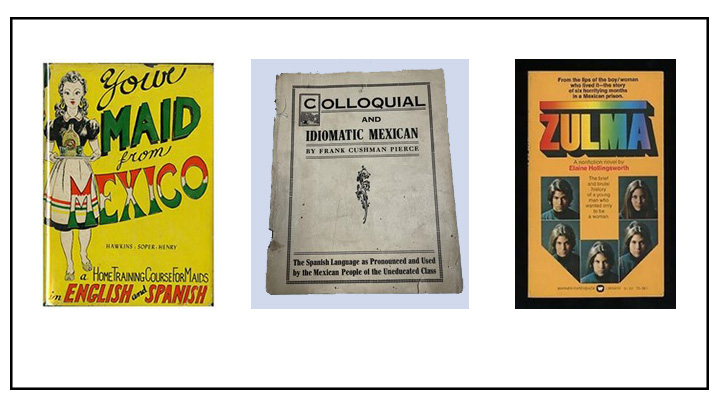
New and recently cataloged materials now available in Special Collections and University Archives. Patrons can visit SCUA (Love Library 1st floor) Monday - Thursday from 10 a.m. - 4 p.m., and are encouraged to set up an appointment for the best service.
Latin American & Indigenous Acquisitions from Erika Esquivel, Latin American & Indigenous Communities Archivist
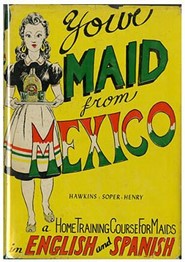
Your Maid from Mexico: a Home Training Course For Maids in English and Spanish
by Gladys Hawkins, Jane Henry and Jean Soper (1959)
Erika's notes: This was used in a couple Chicana/o history courses as soon as we received it. In one class, students had to use two sources to do a primary source analysis and contextualize them with what they were learning about in class and this was a very popular item!
Seller's Note: "At last -- a self-training course for your Spanish-speaking maid. Thousands of housewives have been asking for this book. Book buyers throughout the Southwestern United States have searched for years for a book which would break the language barrier between the homemaker and her Latin-American maid.” A bilingual volume, with a brief English-only section entitled "The Obligations of the Employer." (If the maid reads only Spanish, she is not privy to the explanation of the employer's obligations -- only to her own.)
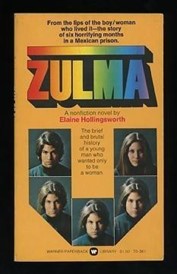
Zulma
by Elaine Hollingsworth (1974)
The “nonfiction novel” Zulma, written by Elaine Hollingsworth in 1974, is typical of a wave of sensationalist paperbacks about transexuality, which were popular in the United States from the 1950s through the 1970s. Hollingsworth based Zulma, however, on tape-recorded interviews with the eponymous narrator, and claims that the book followed the interview transcripts closely. A careful reading of the text makes it clear that Zulma shaped her story with her audience in mind - Hollingsworth was a beautiful, relatively wealthy, white woman and a U.S. citizen, who posed as a social worker in order to secure the interviews in a Tijuana jail. Read with caution, Zulma ofers a unique life history of a transgender Mexican migrant sex worker.
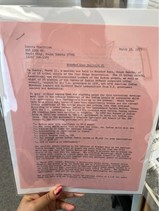
Wounded Knee Bulletin #1. March 19, 1973
Reports on events in the week since the March 11 meeting of tribal chiefs with American Indian Movement leaders that led to the declaration of Oglala independence at Wounded Knee. Seeks donations for legal expenses, food, medicine, and other supplies to be sent to the Wounded Knee Aid Center care of Glide Church in San Francisco.
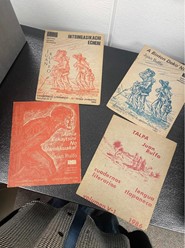
Cuadernos Literarios (1986-1987)
The former National Indigenous Institute, INI (now Comisión Nacional para el Desarrollo de los Pueblos Indígenas) of Mexico published during the 1980's a variety of short stories in diferent indigenous languages largely written by noted author Juan Rulfo and illustrated by Luis Beltran, Ricardo Curiel Villaseñor and Ernesto Celis Zaragoza. Languages include Maya, Purepecha, Mixteca de Oaxaca, Chontal, Tlapaneca, Mixteca de Guerrero, Nahuatl, Tarahumar, Tarahumar Del Este and Spanish.

Tijuana Shopping News (April 1938)
12-page advertising handout, touting the many excellent (and duty-free) bargains to be had by "Mr. Tourist" in the fine shopping emporia just over the border in Tijuana. Issued with "the approval of the Tijuana National Chamber of Commerce," the array of goods advertised in its pages runs the gamut: Oriental rugs, lounging robes, briar pipes, cashmere sweaters, French perfumes, German cameras, silk and rayon pajamas, Swiss watches, and more! There are large ads for Mexicali Beer (advising the buyer to accept no imitations, and to "have bottles opened in your presence"), a bookstore called "Cultura" (offering "Spanish translations of the best foreign writers"), the Original Caesar's Cafe and Restaurant, and of course a couple of marriage and divorce bureaus.

Pedro Bissonette / Wounded Knee leader and warrior / Assasinated [sic] October 17, 1973 / Independent Oglala Nation [poster]
Bissonette, leader of the Oglala Sioux Civil Rights Organization (OSCRO) at the time of his death, was sought by police for his role in the siege at Wounded Knee. Police spotted him in a car and shot him nine times, saying that he had pulled a gun on them.
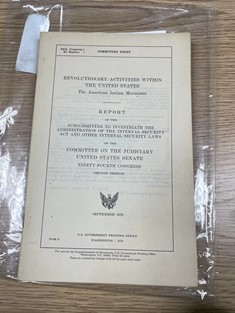
Revolutionary Activities Within the United States; The American Indian Movement : Hearing, Second Session April 6, 1976 and Report, Second Session, September 1976
Documents recording the hearing and report of the Subcommittee to Investigate the Administration of the Internal Security Act and other Internal Security Laws of the Committee on the Judiciary, chaired by James O. Eastland of Mississippi. This hearing was in response to the Wounded Knee Takeover, which began in February 1973 when around 200 Oglala Lakota Native Americans and followers of the American Indian Movement seized and occupied the town of Wounded Knee, South Dakota, on the Pine Ridge Indian Reservation.

Ghost Rider Roads: Inside the American Indian Movement 1971 - present
Stories, interviews and essays from inside the American Indian Movement (AIM) 1971-2011. Ghost Rider Roads chronicles the author's time with various members of old AIM. Includes facsimiles of FBI documents and interview transcripts.
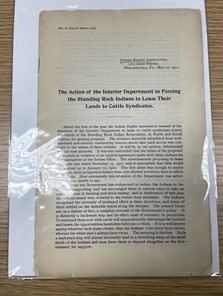
The Action of the Interior Department in Forcing the Standing Rock Indians to Lease Their Lands to Cattle Syndicates (1902)
Published by the Indian Rights Association, formed in 1882 by white reformers to influence public sentiment and Congressional action regarding the civil rights and education of Native Americans. In addition to efforts to influence policy, they tracked the actions of Indian Bureau agents visited reservations to monitor Native American living conditions and health care needs and sponsored speaking tours to inform the public about Native American issues. The group exercised considerable influence on American Indian policy through the 1930s. This pamphlet protests the Department of the Interior's decision to lease grazing rights to ranchers on large portions of the Standing Rock Indian Reservation in North and South Dakota. As a result of pleas from various parties to the Commissioner of Indian Affairs, the plan to lease reservation lands to white ranchers was actually reversed just before this pamphlet went to press. The vociferous protest became a model for addressing future disputes.
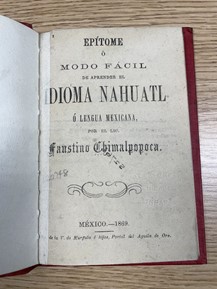
EpÍtome Ò Modo Fácil de aprender el Idioma Náhuatl, EpÍtome Ò Modo Fácil de aprender el Idioma Náhuatl (1869)
Author Faustino Galicia Chimalpopoca or Faustino Chimalpopoca Galicia was an indigenous Mexican lawyer, professor, translator, and administrator. He was the most active scholar of the Nahuatl language of the 19th century.

Group of Sixteen Chapbooks from the Biblioteca del Niño Mexicano (1900-1901)
Sixteen issues of the titillating and gory "Biblioteca del Niño Mexicano" series of books for children. The Biblioteca consisted of five series: stories of indigenous tradition, discoveries and conquests, the colonial era, independence, and the modern era. José Guadalupe Posada made 440 drawings for the collection, and each issue consisted of sixteen pages with chromolithograph covers and three in-text illustrations dripping with blood and violence.
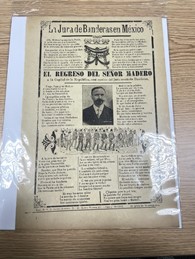
La Jurada de Banderas en Mexico, Print by Jose Guadalupe Posada (1911)
A scarce August 1911 political broadside published by the titan of the Mexican popular press, Antonio Vanegas Arroyo. The work prints a song celebrating Francisco Madero following his revolutionary defeat of Porfirio Diaz earlier that year and his imminent ascendancy to the Presidency of Mexico. "La Jura de Banderas en México" rhapsodizes that the people await Madero in Mexico City to pledge allegiance to him with their flags and banners, and praise him as the savior of the country and its liberty. The broadside also prints two illustrations, one a photographic portrait of Madero and the other a Posada vignette of a military parade. A striking and ephemeral document of a hopeful moment in the history of Mexico that was dashed two years later with the deposition and execution of Madero by his deputies.
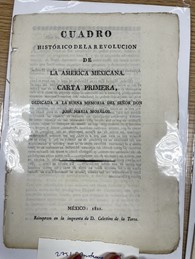
Cuadro Histórico de la Revolución de la América Mexicana. Carta Primera (1821) / y Segunda (1821?)
Both parts of the first edition of this important and contemporaneous account of the Mexican Revolution by one of its key participants. Carlos Maria de Bustamante, writer, publisher, and sometimes politician, was one of the earliest proponents of independence, and this present work is dedicated to his close ally José Maria Morelos. The first part celebrates newly achieved independence and discusses the background of the revolution and some of its earliest events. The second part discusses the origins of Don Miguel Hidalgo y Costillo, the leader of the first independence movement, and some of the events of early 1810.

Compendio del Arte de la Lengua Mexicana (1759)
Scarce second edition of this significant Nahuatl grammar. The first edition was published over a century earlier in 1645, by Juan Ruiz and is very rare; a complete copy has not appeared at auction since 1971. Carochi, born in Florence in the late 16th century, was sent to Mexico after joining the Jesuits and became the foremost authority on Mexican languages of the 17th century. The present work was edited and abridged by the prominent Mexican-born Jesuit scholar Ignacio de Paredes, himself an influential and prolific teacher of native languages in the 18th century. The frontispiece consists of a famed, elaborate engraving of St. Ignatius by Salvador Hernandez y Zapata.
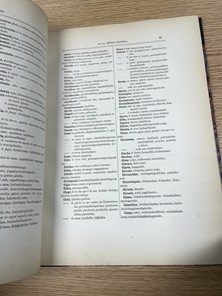
Vocabulario Castellano-Zapoteco publicado por la Junta Colombina de México con motivo de la celebración del cuarto centenario del descubrimiento de América (1893)
Scarce Spanish-Zapotec dictionary published by the Colombian Junta of Mexico on the occasion of the Fourth Centenary of the Discovery of America.
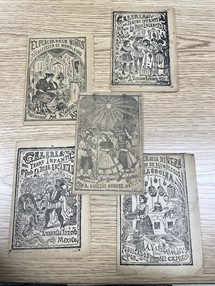
Group of Five Chapbooks with Covers Illustrated by Posada (1918-1920)
A nice group of chapbooks for Mexican children, printed by Antonio Vanegas Arroyo and the heirs of his press during the first two decades of the 20th century. The covers are illustrated by José Guadalupe Posada in his familiar style, and the works themselves include examples of short theatricals and collections of popular songs and stories. A small but representative collection of Posada-Arroyo material, illustrating their influential work in the realm of popular children's works during this period.
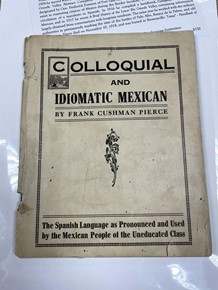
Colloquial and Idiomatic Mexican (1916)
A rare pocket guide to colloquial Spanish intended to be used along the Texas-Mexico borderlands during the time of the Mexican Revolution and the Texas Border War. The author, Frank Cushman Pierce, was a local lawyer and genealogist with a long history in south Texas and thus ideally suited to author such a work. The text lists the English, Spanish, and pronunciation for over 600 common colloquial terms, followed by translations for weights, measures, four pages of "most used verbs," fruits, trees, and flowers, Mexican food, parts of a house, topography, family terms, words and phrases for use in various stores, and two different sections listing terminology specific to the military.
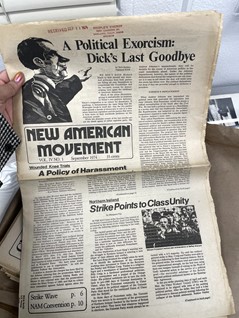
New American Movement [25 issues] (1974-1976)
Articles on the American Indian Movement, Richard Nixon's resignation, African American workers, the Puerto Rican independence movement, the Palestinian liberation movement, abortion rights, the women's movement, gay liberation, and more.

